#paul raymonds reviews
Text
Texas Chainsaw 3D (2013)
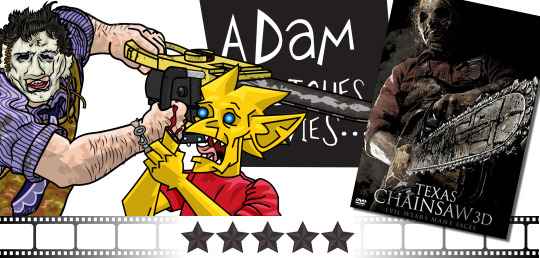
While I didn't enjoy this film, that doesn't mean you won't. No matter what I say, the people involved in this project did it: they actually made a movie. That's something to be applauded. With that established...
I keep returning to the Texas Chainsaw Massacre franchise hoping someone will find something to do with it but all I get are zero-star movies. Texas Chainsaw 3D is the latest in a series of bad decisions. It’s a laughable slasher whose plot is so poorly conceived I wonder if you’ll believe me when I tell you about it or think I’m trolling.
Following the events of the original film, the people of Newt, Texas, burn down the Sawyer clan farmhouse, killing the entire murderous family. All except for baby Edith Rose Sawyer, who is adopted and raised without knowledge of her true family. Years later, the re-named Heather (Alexandra Daddario) receives a letter from her real grandmother, who has just passed away. Travelling to the mansion she’s inherited with her boyfriend Ryan (Trey Songz), best friend Nikki (Tania Raymonde), Nikki’s boyfriend Kenny (Keram Malicki-Sánchez) and a hitchhiker they pick up on the way (Shaun Sipos), they are unaware a surviving Leatherface (Dan Yeager) lives in the basement.
Where to begin? Firstly, this picture makes the catastrophic mistake of trying to make Leatherface into an anti-hero, asking us to ignore that whole cutting people in half with a chainsaw, chopping up innocents into stew and skinning travellers so he can wear their faces thing. It’s bewildering beyond words. Director John Luessenhop tries to make the killer sympathetic by introducing a bunch of new villains: a murderous troupe of rednecks who murdered the Sawyer family years ago. How many years ago? Even the film can’t get it straight. The original Massacre took place in 1974. That would make Heather roughly… 39 at the time this film was made, unless - of course - it was set in in the '90s, or earlier. Except it isn’t. We know because we see a police officer - the dumbest police officer in any slasher movie - brandish a smart phone so he can livestream his investigation to his peers at the police station. This means the “teens” in this slasher movie DO NOT have cellphones… but the adults do. We’re just getting started on how awful Texas Chainsaw 3D gets.
Entirely devoid of scares, this sequel ignores all other sequels (no big loss to anyone who managed to sit through Texas Chainsaw Massacre: The Next Generation) and attempts to capture the raw terror of the original but fails miserably. Its cast of bad actors run around like fools and you can’t wait for them to get sliced. Anything to get this bore over with. Everything about the plot is so contrived it drains the life out of you. It makes you angry thinking someone wrote “but Heather decides NOT to read the letter detailing how the basement houses a hulking cannibalistic maniac with a fetish for gas-powered wood-cutting tools, setting up the grizzly events which followed” and thought “yes, this is good”.
You can take as many dives into the cesspool of waste that is Texas Chainsaw 3D as you want. You'll always find new things to complain about. We’re supposed to believe the first film took place by a small town? I always assumed it was in the middle of nowhere! Even if you separate it entirely from the original - which believe it or not is a good film, unlike all of these follow-ups - this 2013 slasher is a chore to get through, an ugly attempt to cash-in on a brand name that can't end soon enough. Texas Chainsaw 3D isn’t merely bad, it’s inexcusably bad. (2D version on DVD, March 30, 2019)

#Texas Chainsaw 3D#The Texas Chainsaw Massacre#movies#films#movie reviews#film reviews#John Luessenhop#Adam Marcus#Debra Sullivan#Kirsten Elms#Alexandra Daddario#Dan Yeager#Tremaine 'Trey Songz' Neverson#Tania Raymonde#Thom Barry#Paul Rae#Bill Moseley#Gunnar Hansen#2013 movies#2013 films
2 notes
·
View notes
Text
Review of Birthday Stories Selected and Introduced by Haruki Murakami
Oh this one was so interesting. It’s a connection of stories centering or touching on the topic of birthdays. Murakami compiled this anthology and added a short story to accompany it, along with his introduction. The stories were excellent, and each had their own merits and revealed things about their cultural contexts and experiences, which I always find fascinating. I think the thing I want to focus on, though, in this little writing exercise that I catapult into the void, is Murakami’s introduction.
First, the topic of birthdays. What a whimsical little topic to pick. What a silly thing to write about. In some of these stories, the birthday is obviously central. In others, it is merely noted- all of the events would’ve unfolded anyway- but it changes the lens through which we read the story. We can assign such high expectations to this day- our birthday, our parent’s birthday, our partner’s birthday. I, for one, love birthdays! I think it’s a wonderful excuse to celebrate yourself and the people that you love. But we put so much pressure on it. Many of these writers go dark with the birthday stories- birthday strife, birthday tragedy, birthday awkwardness. And it’s so easy to do so: we are supposed to be at such a high, it is incredibly easy to be brought down low, to feel that tension that makes a story a story. We can discuss to what extent the “perfect” birthday is even a myth. Are these sad birthday stories the closest we will get to reality?
The second thing that really struck me was Murakami’s first person writing style in the introduction and this blurbs about the authors. I thought it was so cute and comical. I thoroughly enjoyed it. It strayed far from his usual third person mystical narratives that are a sign of his almost autor nature of writing. It also was jarring then, when I read his story, that I was immediately thrust back into that world of immateriality and surrealism. His ability to shift between the conversational and simple writing to heavily artistic and philosophical writing was interesting to witness within the same 200 pages.
The last thing was just a little point of order that I found to be interesting. He published this book both in Japanese and in English, where he says he did most of the translating work himself into Japanese from the original English of many of the short stories. This surprised me when I read it because I didn’t know he did translations. Most of the work of his that i’ve read has been translated by someone else. What surprised me even more was that when it came time for his story, he wasn’t the one that did the translation from Japanese to English. That boggles my mind a little bit. If you have translator capabilities, wouldn’t you be the most capable one to translate your own work. He would be the one most able to retain the intention and mood behind every sentence. That was just odd to me.
#book review#bookblr#book recommendations#book#birthday stories#haruki murakami#anthology#short stories#russel banks#ethan cabin#raymond carver#david foster wallace#denis johnson#claire keegan#andrea lee#daniel lyons#lewis robinson#lynda sexson#paul theroux#william trevor#japanese author#japanese literature
0 notes
Text
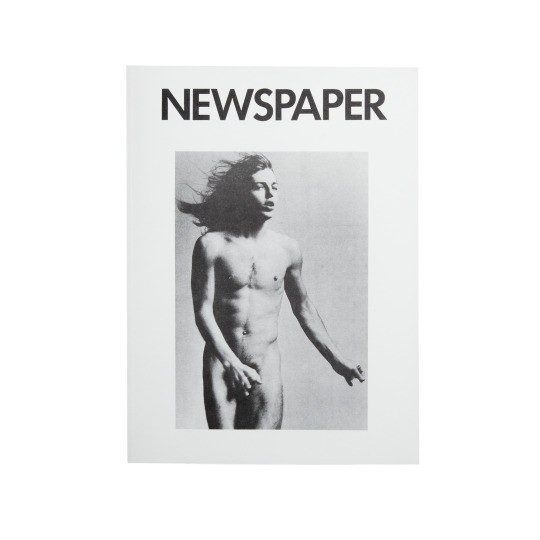




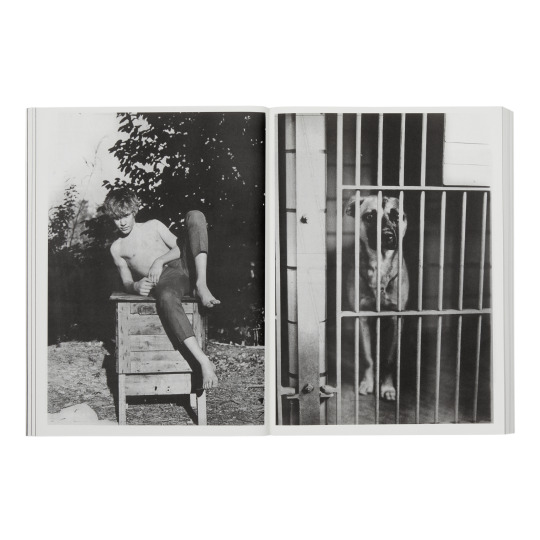
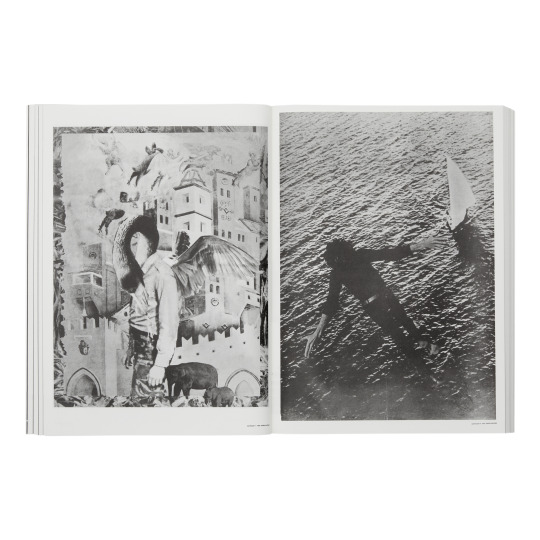


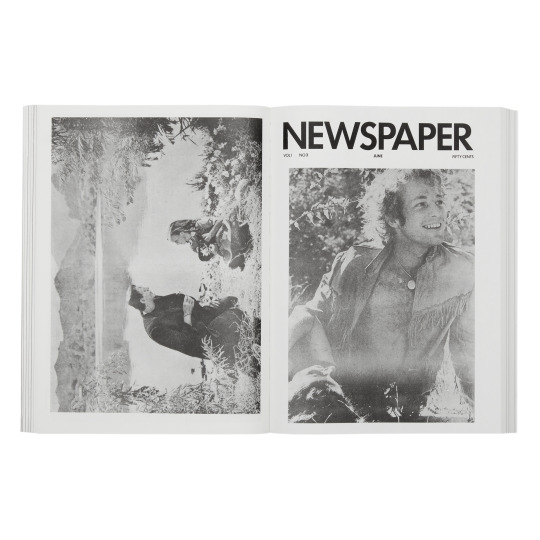

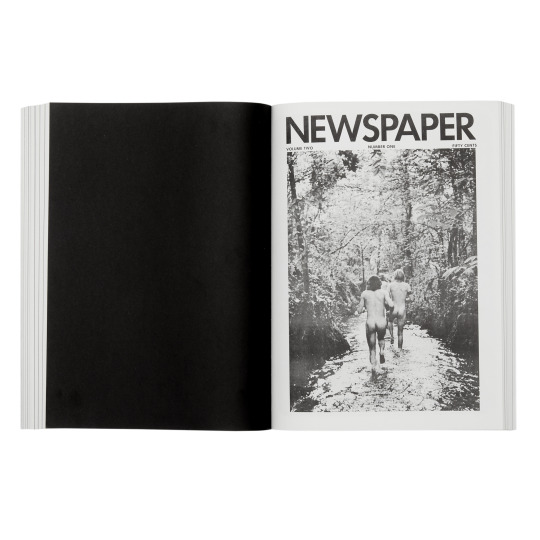
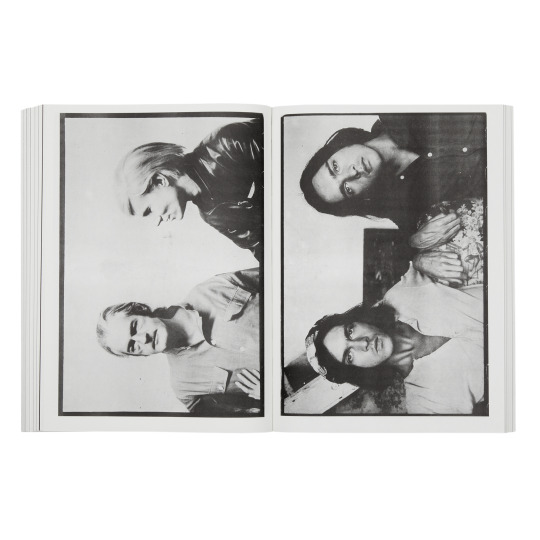
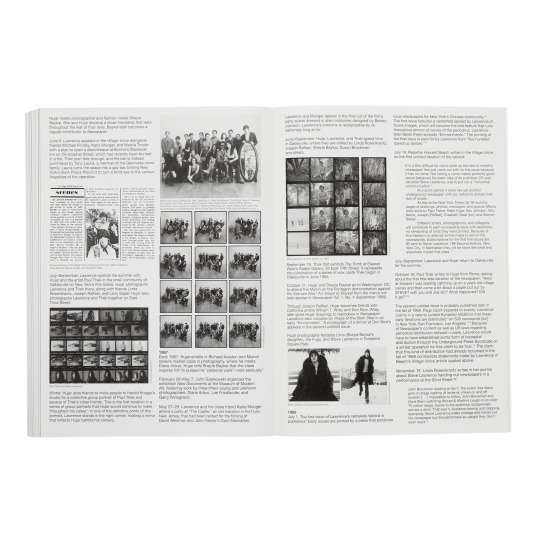
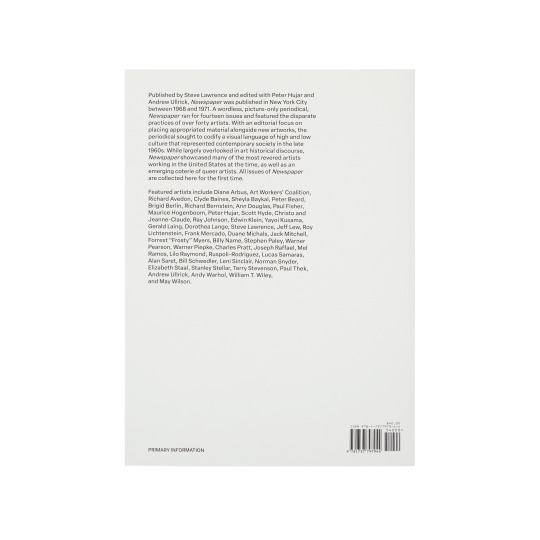
2023年9月15日
【新入荷・新本】
Various Artists Newspaper, Primary Information, 2023
416 pages. 9.75 x 13.38 Inches. Paperback. Edition of 4500.
価格:7,480円(税込)
/
1968年から1971年にかけてスティーヴ・ローレンスが発行し、ピーター・ヒュージャーとアンドリュー・ウルリックが編集に携わったニューヨーク発のタブロイド誌『Newspaper』の復刻版。
『Newspaper』は、言葉を使わず、写真だけを掲載した定期刊行物で、14号にわたって40人以上のアーティ���トの異質な活動を取り上げています。新しい作品と並行して流用された素材を掲載することに編集の重点を置き、1960年代後半の現代社会を象徴するハイカルチャーとローカルチャーの視覚的言語を体系化しようとしました。美術史的な言説からはほとんど見落とされているが、当時のアメリカで活躍し、尊敬されていた多数のアーティストと、新興のクィア・アーティストの仲間たちを紹介しています。
『Newspaper』は、1969年に創刊されたアンディ・ウォーホルの『Interview』や、レス・レヴィンの『Culture Hero』に先駆けるアーティストが発行するタブロイド誌のひとつですが、他のタブロイド紙とは対照的に、『Newspaper』はイメージに特化していました。
その全14号が初めてこの一冊にまとめられています。
Published by Steve Lawrence and edited with Peter Hujar and Andrew Ullrick, Newspaper was published in New York City between 1968 and 1971.
Newspaper was a wordless, picture-only periodical thatran for fourteen issues and featured the disparate practices of over forty artists. With an editorial focus on placing appropriated material alongside new works, the periodical sought to codify a visual language of high and low culture that represented contemporary society in the late 1960s. While largely overlooked in art-historical discourse, Newspaper showcased many of the most revered artists working in the United States at the time, as well as an emerging coterie of queer artists.
The mid to late sixties was a flourishing period for artists experimenting with new media formats such as books, records, and magazines to create or distribute their work. Newspaper was one of the first artist-published tabloids of its era, preceding Andy Warhol’s Interview and Les Levine’s Culture Hero, both of which debuted in 1969. However, in contrast to other tabloids, Newspaper focused strictly on images.
At a time when photography was not being exhibited regularly in galleries, Newspaper provided an alternative exhibition space for the medium and some of the era’s greatest photographers. The publication’s large size and unbound format encouraged readers to take it apart and hang its pages, which was how Newspaper was installed at the Museum of Modern Art’s influential Information show in 1970.
This is not to say that Newspaper only existed within the narrow confines of the art world, far from it. It lived within (and shared contributors with) a robust network of underground and queer periodicals like The New York Review of Sex, Rags, and Gay Power, among others. Yet, unlike many of these tabloids, Newspaper has largely disappeared from the discourse around underground magazines, queer publishing, and artists’ periodicals.
All fourteen issues of Newspaper are compiled in this volume for the first time.
Featured artists include: Diane Arbus, Art Workers Coalition, Richard Avedon, Clyde Baines, Sheyla Baykal, Peter Beard, Brigid Berlin, Richard Bernstein, Ann Douglas, Paul Fisher, Maurice Hogenboom, Peter Hujar, Scott Hyde, Christo and Jeanne-Claude Javacheff, Ray Johnson, Edwin Klein, Yayoi Kusama, Gerald Laing, Dorothea Lange, Steve Lawrence, Jeff Lew, Roy Lichtenstein, Frank Mercado, Duane Michals, Jack Mitchell, Forrest “Frosty” Myers, Billy Name, Stephen Paley, Warner Pearson, Jurgen Warner Piepke, Charles Pratt, Joseph Raffael, Mel Ramos, Lilo Raymond, Ruspoli-Rodriguez, Lucas Samaras, Alan Saret, Bill Schwedler, Leni Sinclair, Norman Snyder, Elizabeth Staal, Stanley Stellar, Terry Stevenson, Paul Thek, Andrew Ullrick, Andy Warhol, William T. Wiley, and May Wilson.
34 notes
·
View notes
Text
Estate Sale Haul!
tagging my book buddies @televinita @simplyshelbs16xoxo and @loubuttons
the woman who owned the house was apparently a bit of a hoarder, but the people running the sale said that a lot of stuff had already been sold, so what I saw was no more cluttered than most estate sales. but this woman’s book collection was insane! books in every room of the house (though granted, it wasn’t a huge house).
most prominent genres were mystery, true crime, history, and cats. this is what I went home with:





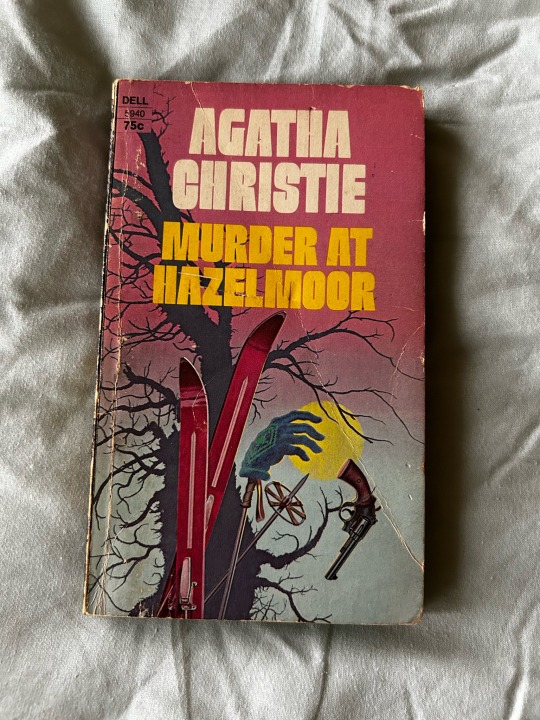
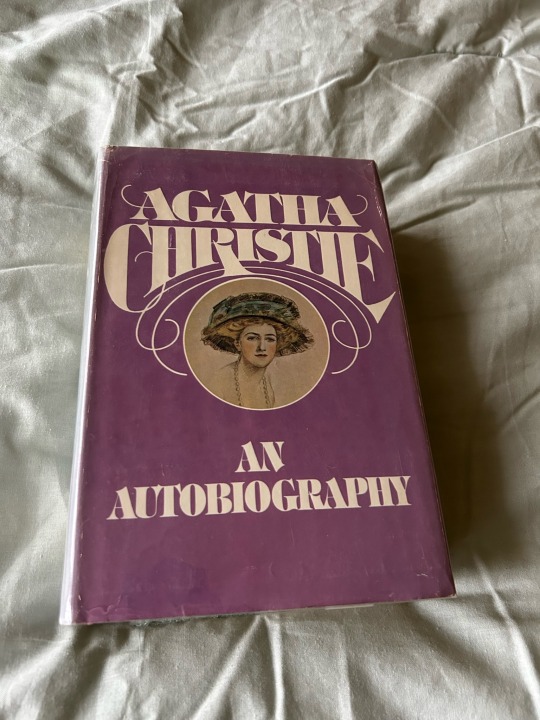
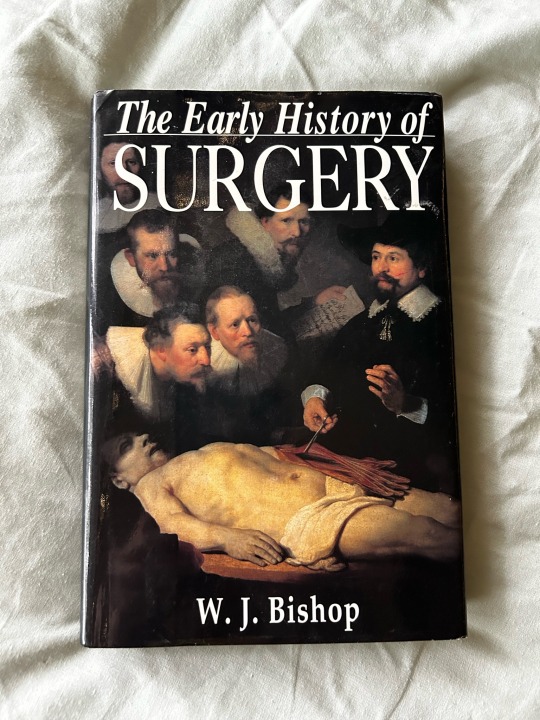

1. Unsolved Mysteries of American History (Paul Aron)
2. The Cases That Haunt Us (John Douglas and Mark Olshaker)
3. History Decoded: The 10 Greatest Conspiracies of All Time (Brad Meltzer)
4. The Crimes of Charlotte Brontë (James Tully) - this one is apparently written by a criminologist and is a fictionalized account of the ~mysteries~ surrounding the Brontë sisters. extremely mixed reviews on Goodreads, but I’m willing to give it a shot!
5. The Ultimate Encyclopedia of Mythology (Arthur Cotterell and Rachel Storm) - there were two different copies of this one, in different rooms
6. Murder at Hazelmoor (Agatha Christie) - there were actually a lot of Christies at the sale, but in an attempt at self-control (ha!), I limited myself to this one and the next:
7. Agatha Christie: An Autobiography - there were also two copies of this one
8. The Early History of Surgery (W.J. Bishop) - as a fan of the Sawbones podcast, I couldn’t pass this one up
9. A Clutch of Vampires (Raymond T. McNally) - a nonfiction account of vampire folklore throughout different cultures in history. unfortunately, the cover is pretty significantly torn, but I’m currently weighing it down with all the other books in an attempt to flatten it so I can tape it later
and finally…

10. The Ghouls (edited by Peter Haining) - published in 1974, this is a collection of horror stories by famous authors such as Edgar Allan Poe, Ray Bradbury, and Bram Stoker. but what really caught my eye was the fact that a) the introduction is by Vincent Price, b) the afterword is by Christopher Lee, and c) it is dedicated to Boris Karloff. as my brother said when I showed it to him, “the gang’s all here!”
all in all, great haul! I’m tempted to go back, but there’s also a library book sale coming up on a week, so I don’t wanna overdo it lol
total cost (including a sweater my mom picked out and a tiny Santa figurine): $15!
13 notes
·
View notes
Text
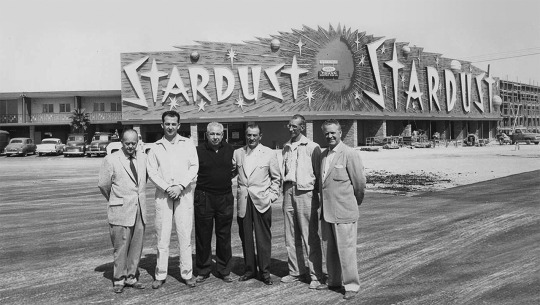
Moe Dalitz & unknown men in front of the Stardust, 1958. The sign is being completed by YESCO before the opening on 7/2/58.
Timeline of Stardust Hotel & Casino
'54: Stardust Inc. formed by T. Cornero, land purchased from F. Fishman, exact dates unknown. Construction begins in Oct. (RJ 7/2/58). Original Stardust logotype by Grace Silver, printed on billboards, letterhead, circa '54-55.
'55: Cornero dies 7/31/55. Stardust Inc. in bankruptcy.
'57: J. & R. Factor purchase hotel; casino, restaurant and bar leased to Karat Inc (Dalitz & partners) (RJ 11/19/57; M. Newton, Mr. Mob, 2007).
'58: Construction resumes in Jan. (RJ 1/14/58). Opened 7/2/1958. Signs designed by K. Wayne, YESCO. Stardust leases Royal Nevada, and incorporates the hotel into the Stardust in '59.
'60: Aku Aku Restaurant opens 1/28/60.
'61: Aku Aku road sign (Polynesian Food/Exotic Drinks) installed next to the moai (Sign of the Times 8/62).
'64: 9-story tower addition.
'66: Left side of the front building sign chopped off during construction of a building between casino & Aku Aku.
'67: Aku road sign removed in Jul, replaced with the base of 188 ft. pylon.
'68: 188-ft pylon completed 2/16/68, design by Paul Miller, Ad Art. Facade sign completed in Mar or Apr, designed by Raymond Larson, YESCO.
'69: Stardust sold to Parvin-Dohrmann Co., later known as Recrion; most staff remains (RJ 12/11/70; M. Newton, Mr. Mob, 2007).
'74: Recrion acquired by Argent.
'75: Sports book addition in Sep. (RJ 9/6/75). “Lido” added to the sign above the reader board.
'76: '68 building sign removed in Jun.; new facade and porte-cochère installed.
'79: Stardust sold to Trans-Sterling Inc (Sachs, Tobman) in Nov.
'85: Stardust sold to Boyd Gaming, finalized 3/1/85
'87: Lower section of the sign’s reader board changed to LED; Aku Aku statue removed and donated to Clark County 11/87, installed at Sunset Park 5/88 (RJ 6/5/88).
'91: Completion of West Tower, 32 fl., Marnell Corrao architect; total rooms 1500 (RJ 8/6/91); logotype on sign changed; “Lido” section removed from the sign.
'00: Remaining four motel wings demolished.
'06: Closed 11/1/06
'07: Demolished 3/13/07
“Curiosity about the sign, presently being erected, brought out some interesting facts. The sign will be 220 feet long and thirty feet high. It will be made up of a translucent world twenty feet in diameter, and on the map of the world will be the location of Las Vegas, indicated by twinkling lights … the luminary Stardust sign, the largest in Nevada” Les Devoir. Vegas Vagaries. Las Vegas Review-Journal, 3/7/58
All images are undated. Below, by Las Vegas News Bureau, and Warner Bros/Getty.

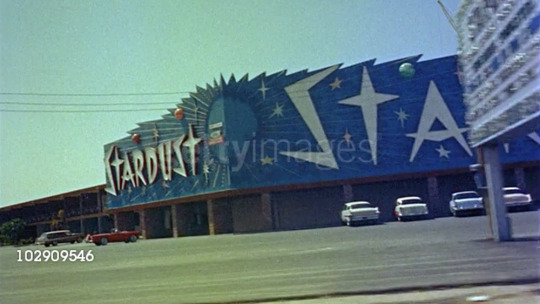

5 notes
·
View notes
Text
youtube
NCIS: Los Angeles Season 14 Rewatch: “Of Value”
The basics: The team works to save a married team of architects with DoD contracts who were kidnapped in front of their children and nanny
Written by: Kyle Harimoto wrote "Omni", "Merry Evasion", "Chernoff, K", "Command and Control" as episode 150, "Granger, O.", "Ghost Gun", "Kulinda", "767", "Se Murio El Payaso", "Assets"/"Liabilities", "Venganza", "Superhuman", "One of Us", "Let Fate Decide" (season 11 premiere), "Decoy", "Answers" , "Watch Over Me", "Cash Flow", "Fukushu", "Bonafides" and “Come Together” (season 13 finale). He co-wrote "Three Hearts", "Leipei", "Humbug", both ends of the "Matryoshka" two-parter, "Smokescreen" part two, "Searching", "A Fait Acompli" and "A Tale of Two Igors" (season 12 finale).
Directed by: Diana C. Valentine who directed "Lokhay", "Fallout", Three Hearts", "The 3rd Choir", "Forest for the Trees", "Beacon", "Unspoken", "Seoul Man", "Crazy Train", "Under Pressure”, "Better Angels" and “The Circle”. This is Valentine’s first episode with the series since season 11.
Guest stars of note: Bar Paly as Anastasia "Anna" Kolcheck and Duncan Campbell as NCIS Special Agent Castor are both back from “Come Together”. Gregory D. Gadson as Army Colonel Jackson Ladd, Sigrid Owen as Mila Curren, Regina Ting Chen as Navy Commander Cheng, Melanie Hawkins as Linsey Sandhagen, Lawrence J. Hughes as Emmett Sandhagen, Elester Lantham as Jerry, Dominic Zamprogna as Paul Figueiredo, Kaya Jackson as Sophia Sandhagen, Devin Looc as Ty Sandhagen, Matthew Law as Josh McCall, Alain Mora as Chito Aldana, Torshawn Roland as Jay and Glen Steele as Man.
Our heroes: Are oddly paired up in this episode.
What important things did we learn about:
Callen: Wanted to be an architect when he was a kid.
Sam: Taking Raymond to a specialist in Orange County.
Kensi: Parent teacher meeting attendee.
Deeks: Getting in required time at the range.
Fatima: Likes the Lakers, especially Lakers games with her dad.
Rountree: Running Ops like a boss.
Kilbride: Searching for a friend.
What not so important things did we learn about:
Callen: Misses Sam while teamed with Deeks.
Sam: Absent.
Kensi: Not a big sister to Fatima, certainly not a favorite aunt.
Deeks: Writing essays and not doing calculus.
Fatima: Using the entirely wrong skincare products according to her mom.
Rountree: Arguing with Kilbride about college football.
Kilbride: Arguing with Rountree about college football.
Where in the world is Henrietta Lange? Not a mention.
Who's down with OTP: Kensi and Deeks spent almost no time together in this hour. The chatted about Rosa to start the episode and grabbed a bite with Callen and Fatima to end the hour. Callen and Anna had a nice coffee run to start the day and some wine in the garden at the end.
Who's down with BrOTP: Forget the bros, Kensi and Fatima were sisters doing it for themselves. They had a lovely chat in the Kensi’s Audi, worked hand in glove to save the day.
Fashion review: Callen wore a blue/green/white plaid button down shirt. A white with thin black stripes henley for Kensi. A grey long-sleeve tee for Deeks. Fatima is wearing a white turtleneck under a royal blue sweatshirt. A denim jacket with a pink tee-shirt for Rountree. A blue three piece-suit with a white dress shirt and red tie for the Admiral.
Music: Lots. This is season one level of music usage. “Collect Your Things and Run” by Hot Water Music opens the episode in the teaser. “L’enfant roi” by Noir Desir plays as Kensi and Fatima are taking out the bad guys. “Blue on Black” by Kenny Wayne Shepherd is playing at the bar where Col. Ladd is drinking. “Good Things Come with Time” plays while Callen and Anna are having a moment at the end of the episode.
Any notable cut scene: Not today.
Quote: Col. Ladd: “When I was a junior officer, I was a door kicker. First one through every time. Every time. Then I moved to Intel, where I protected and led some of the toughest, most well-trained men on the planet. And you know what happened on Sunday? I'm walking into the store. Old lady runs ahead of me opens the door, looks at me with those eyes. Like I was less than. I was a damn super hero, Hollace. And now I got some old lady's pity.”
Anything else: A young guy is skateboarding down a street with a friend recording him. As they wrap out this shot, a delivery robot, Yum Inside, tries to pass them. They think about stealing the food inside when an older neighbor tells them to not to steal. Things get tense until a van comes barreling down the street. It runs over Yum Inside (RIP) with food and beverages going everywhere. A woman runs to the older man and the skateboard crew yelling “stop that van!”
Callen and Anna are walking home from a great coffee shop near their new home. She has a job interview with the Surfrider Foundation, an environmental group. Callen is bit surprised Anna is leaving law enforcement but remembers she made up a story about working in an area destroyed by fires when she was looking for Katya. They pass an older man gardening. Callen has a Pembrook flashback.
Updating Deeks by phone, Kensi is leaving a meeting with Rosa’s teachers, who are impressed with how well she is doing considering the turmoil she been through over the last six months. The teachers did notice that Deeks helped write one of her essays and that Rosa could use a math tutor. Deeks thinks they should be the people Rosa turns to when she has problems. Kensi agrees. She’s ordering a calculus text book and Deeks can start tutoring her immediately. For the sake of the economy, Deeks thinks they should hire a tutor.
Callen arrives to a nearly empty office. Fatima is there with news that Sam is taking his father to see a specialist in Orange County. She also mentions that Kilbride and Rountree are fighting over college football but she quickly tuned that out. Callen is surprised – Fatima said she was a sports fan. No, she’s a Lakers fan and a Lakers fan when she can go to a game with her dad. Callen asks about Fatima’s mother, who is doing well. So well, in fact, that she can focus her attention on all the things Fatima is doing wrong with her life. Starting with skincare. Callen finds this all interested so he’s joining them for the next family brunch. Rountree texts Fatima – he's in Ops and they have a case.
The case is the kidnapping of Linsey and Emmett Sandhagen from their Westwood home. The kidnapping was witnessed by their nanny, Mila Curren. The Sandhagens have two children – a boy and a girl - and are architects. Callen asks why NCIS is involved. Rountree explains that the Sandhagens specialize in designing secure facilities and are civilian DOD contractors working close with the Seabees. Callen details Kensi and Fatima to Port Hueneme to talk to the Seabees while he and Deeks will interview Mila Curren.
With Agent Castor, the Sandhagen children are playing a game in the interview room. Juice boxes for everyone. Curren is being interviewed in the boatshed’s main room. She was getting the kids ready for school when she heard Emmet yell. Three men with ski-masks were in the kitchen as she started down the stairs. Seeing the men, she ran back upstairs and put the kids in a secure safe room.
Deeks asks if the men went after the kids – they did not. Curren is confused since the house has a lot of pricy items, expensive pieces of art. The only thing the kidnappers wanted was the Sandhagens. Asked about any stress points in their lives, Curren is stunned – the Sandhagens are the nicest people. Everyone loves them. They took her on a family vacation with the kids to Hawaii. There were no money issues. Curren is upset for the children and Deeks looks worried too.
In Ops, the Admiral arrives, asking if Kensi and Fatima are at Port Hueneme yet. They are about 20-minutes out. He asks Rountree for information about a Col. Jackson Ladd. Rountree finds some info but it likely isn’t current. The address had Col. Ladd’s name removed from the utilities a while back. Rountree asks about Ladd. The Admiral calls Ladd the finest the man to ever serve in the Army in every conflict going back 25-years. In his last deployment, Ladd lost both legs in a door breech explosion. Ladd is struggling to figure out where he belongs in the world after being the best of the best and losing it all in an instant.
Driving to Port Hueneme, Fatima asks Kensi about “the whole parenting thing” – easier or harder than they thought it would be. Kensi says it isn’t easier or harder, just different. She was so worried about how Rosa would be emotionally after settling in with them but things are going really well.
Kensi asks about Fatima about Akhil. Fatima thinks they are solidly in the friend zone. Fatima isn’t sure what she wants. The last time she was dating, she was acting, partying, going out all night every night. After the accident, she changed everything about herself. Literally, everything except her family. Kensi thinks it is a good thing. Fatima agrees but New Fatima doesn’t know how to do relationships the way Old Fatima did. Kensi likes the New Fatima and is honored to consider her a friend. Fatima is happy since she admires Kensi. Kensi stops Fatima and tells her not to compare her to an older sister. Fatima wouldn’t, she thinks of Kensi more like a favorite aunt. That didn’t go well.
Exiting interrogation, Castor tells Callen and Deeks how much he likes the Sandhagen children. Callen thinks for their safety, Castor should take the kids and Curren to Seal Beach and have them guarded at the base. On the plasma, Rountree has the Sandhagens’s financials. No credit card debt, large savings and retirement accounts. There is a vacation home in Hawaii. Deeks thinks he and Kensi are just like the Sandhagens except for the vacation home, saving and retirement accounts and oh yeah, money.
Signing off with the boatshed, Rountree turns to a returning Admiral with questions about Ladd. Rountree hasn’t found any credit card or ATM activity in days. The Admiral wants LAPD to do a welfare check at Ladd’s home.
Finally at Port Hueneme, Kensi and Fatima meet with a Commander Cheng. Cheng supervises the work done by the Seabees. The Sandhagens were well-regarded by both the Seabees and the Navy staff. Kensi asks about what the Sandhagens did for the Navy. As soon as Kensi asks a question, Cheng stops and asks about the Sandhagen children. She is relieved to hear they are safe.
The Sandhagens are civilian contractors currently working with on three of the Navy’s top projects. Fatima explains that the SECNav has been in contact with Kilbride. The three projects all have enhanced security since the kidnapping. The three locations include a weapon depot at Camp Pendleton and an underground drone control base in the Mojave. The third location was the Sandhagens’s “masterpiece”. Kensi and Fatima were not briefed on that project and could only speak in person with Cheng about it.
The third location is a multiservice missile deterrence command and control center built directly into a mountain in a classified location. Cheng can’t share the location with Kensi or Fatima. The command center is responsible for over 300 missiles on US soil. If a hostile foreign government or terrorist get control of that location, they could “take out most of our domestic military operations with the ballistic missiles,” according to Cheng.
Back on the plasma, Rountree found a partner in the Sandhagens business. Paul Figueiredo has some money but it all pales in comparison to the Sandhagens fortune. And he has a ton of credit card debt. They are all equal partners in the firm. Deeks wonders if the Sandhagens are funneling company profits right into their accounts. Callen thinks they could be selling classified info to the highest bidder.
Paul Figueiredo is in the boatshed’s main room – Castor picked him up. He’s sick about what happened to the Sandhagens and will do whatever is needed to help. But first he asks about Ty and Sophia – the Sandhagen children. He’s also asking if Mila is with the kids. He’s relieved to hear they are all in a security location.
Callen asks about the business. Figueiredo owns a third, Linsey owns a third and Emmet owns a third. Looking at the Sandhagens’s financials and Figueiredo’s, Callen points out the difference. Figueiredo is a bit surprised he was being investigated but he has nothing to hide. He explains that while he is a partner in the military contracting business, the Sandhagens have a civilian business and he’s not a part of that.
It is Deeks’s turn to be surprised since there is no record of that business in any of the Sandhagens’s financials. That was intentional, according to Figueiredo. The business is held by a series of trusts so make sure nothing could be traced back to the family. The civilian jobs were safe rooms in houses and businesses, “bug out” cabins in the mountains. Wealthy people are willing to pay for safety.
Figueiredo was offered an equal share in that business but he wasn’t interested. Unlike the Sandhagens, he doesn’t live to work. Working allows him to camp, hunt, surf, do jujitsu – things he wants to do. Callen asks if he has any remorse about not joining with the Sandhagens when he saw the money coming in. He doesn’t because the Sandhagens worked 24/7/365 to get the business launched. And it was a huge accomplishment. While Figueiredo does not know who the Sandhagens’s private sector clients were, he knew all business was done from their home office.
Driving back from Port Hueneme, Kensi tells the Admiral they are about 40-minutes out. The Admiral is going to send Kensi and Fatima a list of the Sandhagens’s private clients. This makes more sense – anything the kidnappers could get from private clients would be a lot easier to sell than military items. The SECNav is still protecting the military projects.
Deeks is blown away by the Sandhagen home. Being an architect pays. Callen mentions wanting to be an architect as a kid. Deeks thought he’d like it too without the math and engineering. Near the door is a group of fun family photos of the Sandhagens – family events, skiing, bike riding, just living their happy lives. Deeks is horrified they were taken from their own home. Callen asks about Rosa. Deeks is in awe – Rosa fit in a like a champ though he’s pretty sure she’s really sick of him asking if there is anything she wants to talk about. “Well, I think we all are at this point,” Callen snarks.
Deeks asks about the engagement. Callen tells him that Anna is looking at life in Los Angeles without a career in law enforcement. Deeks is sorry that Anna wants out of law enforcement but understands better than anyone the downside of a “two badge family.” Deeks starts talking about future Callen-Anna kids but Callen is happy to have found the Sandhagen office.
With Rountree, Callen and Deeks get a list of the Sandhagen clients. The Admiral is now back in Ops. There are a lot of banks, stores and high net-worth individuals on the client list. Kensi-Fatima and Callen-Deeks are going to check clients near their locations, the FBI HRT will also help.
Rountree breaks the news to Kilbride that LAPD found nothing but some empty whiskey bottles and a lot of empty beer cans in Col. Ladd’s home. The Admiral is waiting for another bit of bad news but the empty bottles and cans were Rountree’s sad story. The Admiral is outraged. Long before meditation and mindfulness unleashed by Rountree’s generation, “many, many generations before you achieved the exact same result using a combination of whiskey and beer.” The Admiral storms out.
Kensi and Fatima checked out an armored truck depot and a fancy watch store. Next on their list is a Santa Monica bank, a place called Even Mavrik and a high-end cigar and wine place. Kensi wants to go back to Even Mavrik, which in Hebrew mean “brilliant stone.” They are diamond brokers.
As Callen and Deeks leave and Sandhagen home, Rountree calls. The client list was last downloaded a month ago. Callen thinks it could be for quarterly taxes but the Sandhagens were working on a project in Port Hueneme. Commander Cheng verified they were with her. Mila the Nanny becomes a suspect.
Castor brings Curren to the interrogation room. She notices it is a lot more cramp than the outside area where she was questioned earlier. Deeks want to clarify that Curren was working for the Sandhagens since she graduated from Harvey Mudd, one of the country’s top colleges for engineering. Curren explained that it took her a little longer to finish college because she didn’t have rich parents but she graduated with a computer science degree.
Deeks mentions the $230,000 in student loan debt. And while the Sandhagens pay well, with rent, cellphone bills, Wi-Fi costs and food, that doesn’t leave much for monthly student loan payments. But even with all money going out, Curren hasn’t missed a loan payment. She tries to explain that she’s worked hard but Deeks cuts her off. He knows it is hard to come up with spare cash like that every single month to buy a money order from the local 7-Eleven to pay for the monthly loan. Curren asks if that is a problem. It isn’t, Callen tells her, as long as she has records for the incoming cash. She sells clothes to Buffalo Exchange and they pay in cash. It’s not a problem for Deeks, he’ll just get the records from Buffalo Exchange.
Nervous, Curren explains that her parents were so excited when she got into Harvey Mudd. They just didn’t understand how much debt she’d wind up incurring by getting her degree. She actually makes more money as a nanny than she would working and using her degree. With a sick mother, Curren has to live in Los Angeles but it is impossible with the debt she has. Playing bad cop, Deeks wants to know who gave her the money. Good cop Callen knows that Curren doesn’t want to see the Sandhagens hurt and wants the kids to see their parents again.
Curren explains she met a man in a restaurant. He was so nice. She now owes him so much money there is no way to pay her back. The man wanted to rob a place the Sandhagens designed. She never thought they’d be kidnapped, she never thought anyone would get hurt. The man’s name is Josh McCall – Deeks is on the phone with Rountree trying to track McCall down.
Kensi and Fatima come up to the building – a very locked-up building - housing Even Mavrik. One of the vents has been removed. Kensi and Fatima go in.
Josh McCall, according to Rountree, has been in and out of the system his entire life. DUI, assault, grand theft auto to name a few of his crimes. LAPD RHD believes he is working with Chito Aldana, who runs a high-end heist crew. They robbed an art gallery in Beverly Hills recently. Callen and Deeks are going to check out McCall’s home.
Kensi and Fatima are checking out the insides of Even Mavrik. While they are looking around, Aldana is checking in with McCall. He wants to know what is taking so long. The diamond dealers locked themselves inside in their diamond vault. Since the Sandhagens built them, they can probably get into the vaults. Kensi and Fatima worry that once the Sandhagens get into the vault, they’ve outlived their usefulness. Kensi tries to call the office but there is no service. Without their cellphones or ability to use their guns (too much noise), Kensi and Fatima have to rescue the Sandhagens on their own.
Callen, Deeks and the tactical team go into McCall’s home. It’s empty. Deeks keeps talking and Callen misses Sam. Deeks finds some lottery tickets and is bothered that Callen misses Sam. He sends a photo of the tickets to Rountree.
The Admiral and Rountree are concerned that Kensi and Fatima are offline. Rountree goes back to when they last had cell service and found that McCall and Aldana have a scrambler. He has no idea where they are.
A guard is walking through Ever Mavrik when Fatima stun guns him. As she and Kensi hide his body, a co-criminal calls for the guard. Kensi puts him in choke hold. She drags him to the room with the guard. Taping both of the bad guys’ mouths closed, the women lock the men into a janitor’s closet.
Outside the vault, Kensi tells Fatima she sees the Sandhagens working on the vault. McCall starts yelling that Red and Bobby are gone. Kensi and Fatima hide while McCall and Aldana talk. Aldana thinks Red and Bobby ran but McCall has Red’s guard hat. It fell off during the struggle with Fatima. Aldana believes the facility has more real guards on duty. Aldana wants the guards found now. “You won’t leave this building alive.”
Rountree traced the lottery tickets to a gas station outside of Ever Mavrik. Callen and Deeks are on their way. Deeks asks if Kensi and Fatima are on their way. Rountree mentions they are missing and Deeks is not pleased. “Find them.”
As the Sandhagens manually drill through the vault, Aldana is getting impatient. When Emmett tells Aldana it will take as long as it takes, that gets Emmett a gun pointed at his chin. Fatima wants to go in but Kensi stops her – Aldana needs the Sandhagens. McCall returns with an extra goon. Extra goon is going to stay with the Sandhagens, Aldana and McCall are going to search the building. Kensi is going to distract Aldana and McCall while Fatima works to rescue to the Sandhagens.
Kensi breaks some glass on the first floor so Aldana and McCall are on the move.
Deeks tells Rountree he and Callen are five minutes out. When he asks about Kensi, Rountree doesn’t haven an answer.
Aldana finds a door ajar. Opening the door, he finds Red and Bobby. Kensi finds a pipe and whacks Aldana in the head. He joins Red and Bobby in the unexpected nap room.
While the Sandhagens are working, the goon hears some noise from a printer room. He find a copy machine making hundreds of copies of a smiley face. Fatima comes up from behind him and starts beating him with her baton. Several kicks to the head later, the goon is out cold on the ground.
On the first floor, McCall gets several shots off at Kensi. The two have a good old fashion fight. He tosses her around, she does the same. She gets him into a sleeper hold and the Rock would be proud as how quickly he went down.
Fatima gets the diamond brokers out of the vault. The Sandhagens are assured their children are safe. They are incredibly grateful.
LAPD is taking the bad guys away. The Sandhagens are facetiming with their kids, who are happy Agent Castor got them ice cream. LAPD is bringing them home.
The team recap the case. Fatima is thirsty. Deeks knows about a Cuban place nearby. Kensi is hungry and Callen is paying.
At a bar, Col. Ladd is drinking alone. The Admiral joins him, wondering why Ladd “no-showed” a job interview. Ladd is grateful for what the Admiral and “the guys” are trying to do for him but he’d rather “do a deep dive with a weight belt and no tank” than do phone sales in a cubicle. The Admiral admits the job wasn’t the best match for Ladd. Ladd explains that he was a door kicker as a junior officer – the first one in every time he was sent out on a mission. When he moved to Intel, he led the toughest, best trained soldiers in the world. On Sunday, he was going to the supermarket and an old lady ran to help him at the front door. He felt that she saw him as “less than”.
The Admiral agrees that Ladd was never meant for the private sector. Ladd was a soldier, always was, always will be. Getting him a job with people who don’t understand that was a mistake. And if Ladd puts his drink down, the Admiral will get him a job fit for a soldier. Ladd doesn’t want charity. This isn’t charity. Kilbride won’t be holding the door open for Ladd. The Admiral leaves. Ladd stands up with the help of a cane.
Callen and Anna are hanging out in their garden, sipping wine. Anna got the job but didn’t take it. She would be in the office all day and it wasn’t what she was trained for. Instead, she looking at a company that specializes in finding kidnapped children. She isn’t sure that what she wants either. Anna turns the conversation to Callen. She knows he thought he saw Pembrook earlier that day. He says he did. She understands that he needs to track Pembrook down. “But,” Callen says. So much had to go right for the two of them to wind up together, maybe they should just enjoy the good.
What head canon can be formed from here: The Kensi-Fatima scene during the ride up to Port Hueneme was terrific. The program did a great job over the year with the Kensi-Nell friendship and there, they were planting the seeds for a Kensi-Fatima friendship.
The Admiral’s whiskey and beer rant looked like it had Caleb Castille laughing just a bit.
Col. Ladd was a character this program needed years ago. In seasons one and two, Daniel Hugh Kelly popped up as an unnamed military person who knew things. The program needed that type of character. Kilbride was that character for a while until Nell decided running off with Eric was more fun than running the team.
Finally, this episode had a Covid season feel. Everyone was siloed with another team member and basically worked that that member only. Yes, Callen had a chat with Fatima but that was in a perfectly empty office. There was a short scene with most of the team (save Kensi) in Ops and the meet-up at the end. Not a bad episode but I like the team when they work together.
Episode number: Season 14, episode two. This is 304 overall.
5 notes
·
View notes
Photo
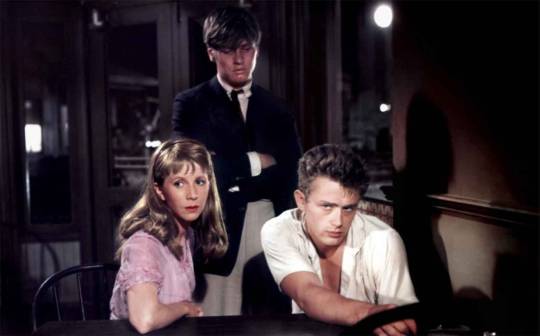
Next up for for FNF prez Eddie Muller at the Turner Classic Movies Film Festival today. He'll introduce Elia Kazan's EAST OF EDEN (1955), 11:45 am, TCL Chinese Theatres, House 1.
#TCMFF film notes:
When director Elia Kazan realized Marlon Brando and Montgomery Clift were too old to play the brothers in his adaptation of John Steinbeck’s East of Eden, he went looking for new talent. Boy, did he find it! In his first starring role (and the only one of his major films released during his lifetime), James Dean burns up the screen with inner turmoil. He’s cast as Cal, the tortured Cain to Richard Davalos’s Abel and Raymond Massey’s Adam in coastal California on the eve of World War I. Rejection dominates Dean’s performance as he strives to win his father’s love, finds himself drawn to his brother’s girlfriend (Julie Harris), and discovers his mother (Jo Van Fleet) is running a brothel in a nearby town.
Working with cinematographer Ted McCord, Kazan reflected Cal’s emotional turmoil in his creative use of the widescreen image. This was Kazan’s first film shot in color and CinemaScope, and he frequently tilts the camera to intensify a scene’s emotional impact. He also worked with composer Leonard Rosenman to make the score mirror Cal’s inner life. At the time, many reviewers lauded Kazan’s move into widescreen while complaining that Dean’s performance was just an imitation of early Brando. More recent critics have hailed the film as Kazan’s and Dean’s best. Van Fleet won the Oscar for Best Supporting Actress with her film debut, with additional nominations going to Kazan, Dean, and Paul Osborn’s adapted screenplay.
d. Elia Kazan, 118 minutes, DCP
World premiere restoration courtesy of Warner Bros. Classics
Restored by Warner Bros. in collaboration with the Film Foundation
18 notes
·
View notes
Text
The History of Video Art
readings listed below:
A History of Video Art (2nd Edition) - Chris Meigh-Andrews
Television: Technology and Cultural Form - Raymond Williams
Video: The Distinctive Features Of The Medium - David Antin
Video: From Technology to Medium - Yvonne Spielmann
Video: The Aesthetics of Narcissism - Rosalind Krauss
The Autobiography of Video: Outline for a Revisionist Account of Early Video Art - Ina Blom
Performance, Video, and the Rhetoric of Presence - Anne M. Wagner
The Evolution of Film Language - André Bazin
Image after Image: The Video Art of Bill Viola - Chris Keith
Video Haptics and Erotics - Laura U. Marks
The Temporalities of Video: Extendedness Revisited - Christine Ross
Video/Media Culture of the Late Twentieth Century - John G. Hanhardt and Maria Christina Villaseñor
Analog Circuit Palettes, Cathode Ray Canvases: Digital’s Analog, Experimental Past - Gregory Zinman
The Unifications of the Senses: Intermediality in Video Art-Music - Holly Rogers
The Modernist Event - Hayden White
Ken Jacobs: Digital Revelationist - Malcolm Turvey
Reverse Shot (Dialogues with Sky Hopinka, Tiffany Sia and Emma Wolukau-Waanambwa) - Emily Watlington
From Nostalgia to Anachrnoy: Omer Fast, Michael Robinson, and Home Video Appropriation - James Hansen
Gillian Wearing, Private I - Nancy Princenthal
Like Life (Review of Cao Fei) - Eleanor Heartney
John Smith: Everyday Disruptions - Mark Prince
Ulysses Jenkins: A Griot for the Electronic Age - Paul Von Blum
From Narcissism to the Dialogic: Identity in Art after the Internet - Melissa Gronlund
The Skin of the Film: Intercultural Cinema, Embodiment, and the Senses - Laura U. Marks
13 notes
·
View notes
Text
2023 Reading Roundup
Everything what I read in 2023
I read a whole bunch.
Heartily Recommend
Visceral Bleh
Reread
*Audiobook*
Fiction
Where the Crawdads Sing by Delia Owens (where is the fucking humidity in your swamp, Delia??)
Days Without End by Sebastian Barry
Lot by Bryan Washington
Mr. Loverman by Bernadine Evaristo
A Court of Thorns and Roses by Sarah J Maas
Trust by Hernan Diaz
The Remains of the Day by Kazuo Ishiguro
The Cellist of Sarajevo by Steven Galloway
The Unquiet Dead by Ausma Zehanat Khan
It Ends with Us by Colleen Hoover
By Nightfall by Michael Cunningham
Wolf Hall by Hilary Mantell (but everyone is called Thomas)
Verity by Colleen Hoover (awful but wacky and hilariously awful)
Katalin Street by Magda Szabo
The Marriage Portrait by Maggie O’Farrell
Our Missing Hearts by Celeste Ng
Animorphs #24 The Suspicion by KA Applegate (a trip)
Lost Children Archive by Valeria Luiselli
The Island of Forgetting by Jasmine Sealy
Everything I Never Told You by Celeste Ng
The Trio by Johanna Hedman
At the Bottom of the River by Jamaica Kincaid
The Whale Rider by Witi Ihimaera
Libertie by Kaitlyn Greenidge
Silence by Shusaku Endo
When Women Were Dragons by Kelly Barnhill
Babel by RF Kuang (was so disappointed by this one)
The Bass Rock by Evie Wyld
Island by Siri Ranva Hjelm Jacobsen
The Gold-Rimmed Spectacles by Giorgio Bassani
Must I Go by Yiyun Li
The 1,000 Year Old Boy by Ross Welford
She Who Became the Sun by Shelley Parker Chan
Ariadne by Jennifer Saint
The Singer’s Gun by Emily St. John Mandel
Memphis by Tara M Stringfellow
The Whirlpool by Jane Urquhart
Get a Life, Chloe Brown by Talia Hibbert
A Country of Eternal Light by Paul Dalgarno
Yellowface by RF Kuang
The Country of Others by Leïla Slimani
The Grass is Singing by Doris Lessing
American Wife by Curtis Sittenfeld
All Passion Spent by Vita Sackville-West
The House of Doors by Tan Twan Eng
Game Misconduct by Ari Baran
Demon Copperhead by Barbara Kingsolver
Uprooted by Naomi Novik (sorry Naomi :/ )
The Foot of the Cherry Tree by Ali Parker
The Big Sleep by Raymond Chandler
Matrix by Lauren Groff
The Twilight World by Werner Herzog
Wild by Kristen Hannah
*The Fraud by Zadie Smith*
The Mountains Sing by Nguyen Phan Que Mai
The Wind Knows My Name by Isabel Allende
Remarkably Bright Creatures by Shelby Van Pelt
This Other Eden by Paul Harding
The Kraken Wakes by John Wyndham (weirdly, one of the best depictions of a marriage I’ve read)
The Nickel Boys by Colson Whitehead
Against the Loveless World by Susan Abdulhawa
North Woods by Daniel Mason
Shadows on the Rock by Willa Cather
The Tiger’s Wife by Téa Obreht
Animorphs: The Hork-Bajir Chronicles by KA Applegate
Roman Stories by Jhumpa Lahiri
Animorphs #13 The Change by KA Applegate
Animorphs #14 The Unknown by KA Applegate
Animorphs #20 The Discovery by KA Applegate (snuck in two more under the wire… #20 is when shit REALLY kicks off. From there it gets darker and darker).
Poetry
Black Cat Bone by John Burnside
Women of the Harlen Renaissance (Anthology) by Various
The Analog Sea Review no. 4 by Various
The World’s Wife by Carol Ann Duffy
Non-Fiction
Besieged: Life Under Fire on a Sarajevo Street by Barbara Demick
Atlas of Abandoned Places by Oliver Smith
Novelist as a Vocation by Haruki Murakami
Empire of Pain: The Secret History of the Sackler Dynasty by Patrick Radden Keefe
Wanderers: A History of Women Walking by Kerri Andrews
City of Laughter: Sex and Satire in Eighteenth Century London by Vic Gatrell
The Lazarus Heist: From Hollywood to High Finance by Geoff White (fully available as a podcast)
The Entangling Net: Alaska’s Commercial Fishing Women Tell Their Stories by Leslie Leyland Fields (very niche but fascinating. Transcribed interviews)
Free: Coming of Age at the End of History by Lea Ypi
Hijab Butch Blues: A Memoir by Lamya H.
Freedom by Margaret Atwood (just excerpts from novels repackaged)
*Born a Crime by Trevor Noah* (Noah’s narration is superb)
The Slavic Myths by Noah Charney and Svetlana Slapšak (was expecting stories, but it was mostly academic essays)
Manga, Comics, Graphic Novels
Safe Area Goražde by Joe Sacco
The Way of the House-Husband, vol. 1 by Kousuke Oono
SAGA vol. 1-6 by Fiona Staples and Brian K Vaughan
Top of the Top:
Born a Crime was probably my favourite non ficition, and most of that probably is due to Trevor Noah's narration skills. It was very entertaining and heartfelt.
Less uplifting but just as gripping in a different way was Empire of Pain. Excellent book that went deep into the why and what and hows of Purdue Pharma. Anger inducing.
Lazarus Heist is great and available as a podcast. The book is more or less the podcast word for word.
Fictionwise: I read Trust at the start of the year and it was a bit soon to declare as favourite of the year, but it's stil made the final cut. Just very imaginative and intriguing. Just my kind of MetaFiction. Clever without being cleverclever.
Demon Copperhead I read right off the back of Empire of Pain so maybe that coloured my experience. I've not read any Dickens so loads of references no doubt flew past me, but the language was acrobatic and zingy. I loved it.
Wrapped up the year on a high with North Woods. That was so unexpected and entertaining. Again with the playful language, memorable characters and a unique approach to tying all the various stories together. One that sticks in the mind and makes the writer in me wonder how I can replicate his style (with my own personal twist of course.)
#a whole bunch of books#reading roundup#Still one day to go but i don't think i'm going to finish anything else#year in books#2023 in books
6 notes
·
View notes
Text
“You know, I had the idealistic notion, when I was 20, that I was going into the theater,” Stephen Sondheim once said. “I wasn’t; I was going into show business, and I was a fool to think otherwise.”
It was a remark characteristic of Sondheim, the titan of musical theater whose decades’ worth of credits as a composer and lyricist included “West Side Story,” “Company” and “Into the Woods.” Here he was as many had seen him in interviews over the years: unsentimental and a bit flip, self-effacing to the point of selling himself short.
Because among musical theater artists of his generation, Sondheim, who died in 2021 at 91, was arguably the most artistic — challenging, unusual, incapable of superficiality in a medium often dismissed as superficial. He was, perhaps to his disappointment, not the best businessman, with shows that rarely lasted long on Broadway. And his work was better for it.
Together, they form a portrait that helps in considering Sondheim’s place among American composers. I say American because Broadway, alongside jazz, is the most homegrown of this country’s music, and his work constantly pushed the art form further. Where so many of his colleagues have operated within standard structures, he, even in writing a 32-bar song, seemed to always ask, “What else is possible?”
It’s also important to consider Sondheim as a distinctly American composer because his writing reflects a creative mind repeatedly fixated on the idea of his homeland, with an ambivalence by turns affectionate and acerbic. It’s there in his lyric contribution to “Gypsy,” arguably the Great American Musical, which the musicologist Raymond Knapp has described as “a version of the American dream that leads, as if inevitably, to striptease.” And it continues, with an unconventional patriotism in “Assassins” and a revealing journey across state lines and years in “Road Show.”
In that sense, Sondheim is not only one of the finest American composers, but also one of the most essential.
“He and Lenny are at the top of that list,” Paul Gemignani, Sondheim’s longtime music director, said, referring also to Leonard Bernstein. “Most Broadway composers are writing pop tunes. Steve never wrote a pop tune. ‘Send in the Clowns’ got lucky.”
Sondheim seemed fated to create musical theater at a higher level than his colleagues. Like Bernstein, he was pedigreed: His mentor, for lyric writing, was Oscar Hammerstein II, of Rodgers and Hammerstein; for composition, the modernist Milton Babbitt. Yet he emulated neither.
In an interview with the Sondheim Review, Sondheim said that he was trained by Hammerstein “to think of songs as one-act plays, to move a song from point A to point B dramatically.” But he thought of them in more classical terms: “sonata form — statement, development and recapitulation.”
I only included the beginning of the article, but I recommend reading the whole thing. Sondheim’s influence and innovation can’t be overstated. We won’t have another like him in our lifetimes.
2 notes
·
View notes
Text
youtube
Proof of an Afterlife: the Shared-Death Experience with Raymond Moody and Paul Perry
In 1975, Raymond Moody coined the term near death experience in his classic book, Life After Life. For half a century, he has researched some of life’s greatest mysteries. As both a PhD in philosophy and an MD, he has had a strong interest in how medical realities intersect with the ineffable realm of philosophy. In his multiple roles as author, professor, public speaker and grief counselor, he has heard thousands of accounts of near death, shared death and after death experiences.
Paul Perry Perry is the co-author of many best-selling books concerning near-death experiences and the afterlife, six of them were written with Raymond Moody. His newest book with Moody is Proof of Life After Life: 7 Reasons to Believe There is an Afterlife.
In this interview, hosted by Christopher Naughton, JD, Moody and Perry focus on the evidential value of the shared-death experience.
00:00 Introduction
04:30 Shared-death experience
16:42 Taboo
24:33 Pioneers
30:23 Religion
37:41 Transformation
40:50 Science
44:25 Life review
50:31 Psychic ability
57:23 Conclusion
2 notes
·
View notes
Text
A review of “Persophilia’ of Hamid Dabashi
“Shaj Mathew reviews Persophilia
Hamid Dabashi. Persophilia: Persian Culture on the Global Scene. Cambridge, Mass.: Harvard University Press, 2015. 296 pp.

Review by Shaj Mathew
28 November 2018
In Persophilia, Hamid Dabashi explores the consequences of the European fascination with all things Persian, examining texts by Montesquieu, Voltaire, Johann Wolfgang von Goethe, and Friedrich Nietzsche; artwork by Paul Gauguin and Henri Matisse; the scholarship of E. G. Browne and Annemarie Schimmel; and even the films of Abbas Kiarostami. Dabashi narrates a dynamic process whereby Persian culture travels outside of its imperial courts, becomes the idée fixe of European artists and intellectuals, and returns from Europe utterly transformed by its cross-cultural and colonial encounters. In recovering this lively but largely unacknowledged artistic and critical circuit of exchange—which begins in seventeenth-century Europe, becomes prominent in the eighteenth and nineteenth century, and continues into the present—Dabashi models a vein of cross-cultural comparison that scholars of all disciplines should heed.
Dabashi investigates the effects of European (and later American) persophilia through an engagement with Edward W. Said, Raymond Schwab, and Jürgen Habermas. Said and Schwab offer causal explanations for Europe’s interest in the so-called Orient. For Said, Europe created knowledge about the “Orient” in order to dominate and colonize it; for Schwab, European artists viewed the “Orient” as an imaginative or artistic substrate. But for Dabashi, “abandoned in both their projects is the fate of the Orientalized societies themselves—or what happens to Persian, Indian, Arabic, or Chinese literary and artistic traditions (and the emerging public spaces that are hosting them) once they have been translated into a European context” (p. 9). To correct this lack, Dabashi turns to Habermas, whose concept of the public sphere allows Dabashi to provide an account of the effects of persophilia that is neither cultural (Schwab) nor political (Said) but social.
This social or societal account of persophilia obviates two biases that tend to dominate critical thought about the postcolonial state: the critique of European Orientalism (which, for Dabashi, “paradoxically assigns universal agency to a Eurocentric conception of the world”) and a radical anti-Western nationalism (p. 206). Although “both sides of this binary—the critique of Orientalism and the appeal of nativism—are both necessary and even logical for the historical circumstances in which they were launched,” Dabashi writes, “at the same time they have both come together paradoxically to rob the postcolonial person of historical agency and moral and authorial imagination” (p. 206). Dabashi’s attempt at restoring agency and imagination to the “postcolonial person” rests on the following claims about the cycle of European persophilia: Persian culture exited its royal courts and entered the emerging European bourgeois public sphere through art, literature, and philology, largely in the eighteenth and nineteenth centuries; this European bourgeois public sphere became transnational in light of this encounter with Persia (and other cultures); this newly transnational public sphere periodically reentered Persia through the circulation of eighteenth- and nineteenth-century texts and through the twentieth-century colonial encounter; and finally, the appropriation of the transnational public sphere by twentieth-century Persians provided them with the tools to resist European imperialism. With each stage of persophilia—from Persia, to Europe, and back—Dabashi underscores the fact that the ideas and texts being exchanged underwent mutations.
Dabashi’s argument unfolds over twelve brief chapters, each of which describes a cycle of persophilia organized around one or two literary or scholarly figures. In chapter two, for example, he describes the windy path of Montesquieu’s Persian Letters (1721), which was inspired by the travels of two Frenchmen to Isfahan in the seventeenth century. Persian Letters of course reverses that voyage, and describes, in epistolary fashion, the satirical observations of two Persians in France; Dabashi’s gloss of Persian Letters allows him to claim that European persophilia was at the heart of the European Enlightenment. In support of Persophilia’s overall argument about cultural flows, Dabashi then demonstrates how Montesquieu’s persophilia came to influence Persian writers themselves. Accordingly, Dabashi zooms in on one Persian intellectual, Mirza Fath Ali Akhondzadeh (1812–1878), who wrote his own epistolary work, the Correspondences of Kamal al-Dowleh (Maktubat-e Kamal al-Dowleh; 1863), after being exposed to the ideas of Montesquieu as well as those of Voltaire and Jean-Jacques Rousseau. Akhondzadeh was a prolific dramatist and essayist whose writings often transliterated words such as “civilization” and “despotism” directly into Persian—“a clear indication,” for Dabashi, that these concepts “entered Persian prose directly under the influence of Montesquieu and other French Enlightenment thinkers” (p. 56). Throughout his wide-ranging career, Akhondzadeh also launched a campaign to latinize the Persian alphabet and debated the merits of liberal democracy. In short, his intellectual production, originally inspired by persophilic European thinkers such as Montesquieu, helped open a public sphere in Persia—a prime example of how Persian culture drifted into Europe and returned to Persia to catalytic effect.
Chapter four, entitled “Goethe, Hegel, Hafez, and Company,” is similarly exemplary of Dabashi’s argument. Here he describes how Goethe’s fascination with Hafez and Saadi Shirazi, newly translated into German during his lifetime, led to the publication of the West-östlicher Divan in 1819. Likewise, for G. W. F. Hegel, these translations created an image of Persia against which he could define European thought in his philosophy of world history. For many German romantic thinkers of the early nineteenth century, classical Persian poetry—with its strains of self-annihilation and rebirth—fed into a form of nationalist mysticism that would ultimately provide cover for the political repression of liberal thought. Romantic beliefs proliferating in nineteenth-century Germany, influenced by their appropriation of Persian and “Sufi” poetic mysticism, had “a joint proclivity toward political absolutism” that reentered Persia in the twentieth century through the thought of Seyyed Hossein Nasr (p. 100). Under the sway of the Swiss-German mystic Frithjof Schuon, Nasr would launch a critique of modernity that “had a direct root in these German sources of romanticism, mysticism, and fascism” (p. 101). Nasr’s antimodern ideology would provide cover for both the Pahlavi dynasty and its destroyer, Ayatollah Khomeini.
The chapters I have sketched above are emblematic of Dabashi’s method in this book, which regularly marshals substantial and engaging evidence to support his cyclical theory of persophilia. Persophilia’s main shortcoming has to do with the last movement of its argument, which asserts that the public sphere in Persia was not restricted to the bourgeoisie and in fact admitted subaltern classes; this claim, while prominent in the introduction, is mentioned only en passant in most chapters, and does not receive the same space and explanatory treatment enjoyed by the work’s other major ideas. In some ways the counterpart to Dabashi’s previous book—The World of Persian Literary Humanism (2012), which narrated the various stages of Persian literature’s understanding of itself in a fashion reminiscent of Hayden White’s Metahistory (1973)—Persophilia joins a wave of scholarship that sheds light on the global origins of phenomena typically considered the province of specific national traditions. Furthermore, it generates new ways of thinking about global culture that do away with tired dichotomies such as East and West, center and periphery, and tradition and modernity. What makes Persophilia an especially urgent and impressive accomplishment is that Dabashi achieves all this without advocating for parity or equivalence and without ignoring the asymmetrical power relations that underlie all encounters between cultures.”
Source: https://criticalinquiry.uchicago.edu/shaj_mathew_reviews_persophilia/

Shaj Mathew, PhD, Assistant Professor at Trinity College, is a scholar of global modernist literature. He writes about literature and film in English, Spanish, Turkish, and Persian, often in a cross-cultural key.
3 notes
·
View notes
Text
Best French Films - Cinéma Saturday - Zazie dans le métro - 1960s Paris
New Post has been published on https://sa7ab.info/2024/08/06/best-french-films-cinema-saturday-zazie-dans-le-metro-1960s-paris/
Best French Films - Cinéma Saturday - Zazie dans le métro - 1960s Paris


From last week's beautiful 17th century setting to this week's firmly in the 20th, French films give us an endless source of inspiration and historic context. Last week's Cyrano de Bergerac, a classic story by Rostand in a beautiful Jean-Paul Rappeneau film left many readers with happy memories of watching the film many years ago. I hoped it inspired you too! If you missed it, find that blog post here.
This week we are firmly in the hustle and bustle of 1960s Paris with ten year-old Zazie, who you might call an original Amélie-like figure. It was no small job turning Raymond Queneau's hilarious novel (1959) full of literary and linguistic tricks into this energetic comedy with masses of visual humour. It's part of what makes this a cult film classic by Louis Malle. Let's find out more!
Cast & Crew
Director: Louis Malle
Cast: Catherine Demongeot, Philippe Noiret, Hubert Deschamps, Carla Marlier, Annie Fratellini,Vittorio Caprioli, Jacques Dufilho, Yvonne Clech,Antoine Roblot, Odette Piquet, Nicolas Bataille
Screenplay: Louis Malle and Jean-Paul Rappeneau
Cinematographer: Henri Raichi
Year: 1960
Genre: Fantasy comedy
Synopsis
A brash and precocious ten-year-old (Catherine Demongeot) comes to Paris for a whirlwind weekend with her rakish uncle (Philippe Noiret); he and the viewer get more than they bargained for, however, in this anarchic comedy from Louis Malle, which rides roughshod over the City of Light. Based on a popular novel by Raymond Queneau that had been considered unadaptable, Malle’s audacious Zazie dans le métro, made with flair on the cusp of the French New Wave, is a bit of stream-of-consciousness slapstick, wall-to-wall with visual gags, editing tricks, and effects.
What I liked about this film
Paris as a playground for exploration. Where would you go first? On arriving at the Gare de l'Est, Zazie (having just arrived from the provinces) only wants to go on the métro. Probably not your first choice! But Zazie's dream is stymied by a métro strike so of course she has to travel in different ways. Here in Paris in 1960 we can explore the city via Zazie's antics like a fast-paced cartoon and with all the colour and life of the 60s (plenty of views of Paris you might never have seen before.)
Certainly this visual comedy is a treat for the eyes and also an exploration of surrealist comedy unlike anything else. Using film techniques, many of which seen for the first time at this period, editing and special effects this film is a riotous journey around the City of Light.
There's a lot to this film, some of which is difficult to grasp, but it is an immense cinematic achievement to bring Queneau's surrealist humour and linguistic games to the screen without ruining both! Ashley Naftule's great review discovers:
Don't expect to use Zazie as a reliable city guide though. Much like Netflix's 21st century Emily in Paris, which mangles all kinds of Parisian monuments in improbable journeys around the city, Zazie's Paris is a jumble. The difference is that Zazie's jumble is for surrealist comic effect and underscores the tourist-in-Paris-for-the-first-time experience along with many jokes featuring coach loads of tourists dressed in all kinds regional dress.
Due to the metro strike, the city is also teaming with cars. Visual references to the car's gradual encroachment on the city give you an idea of period of change within the city. It seems especially interesting too as Paris's current mayor would like to plan to drastically reduce the number of cars in the centre of the city to improve its air quality and create a healthier urban landscape. What goes around…
As the film scholar Ginette Vincendeau says in her essay on the film, 'The characters’ trajectories play havoc with the city’s topography: the Paris of Zazie dans le métro is a jumble of tourist attractions (the Eiffel Tower, the Place de la Concorde, the flea market), hallowed surrealist spots (the Passage Brady), and iconic cinematic locations (the banks of the Seine, the Pont de Bercy).' (Essay available at Criterion Collection, 2011) and most of these monuments are misnamed and misplaced. But this is absolutely part of the charm of the film!
With a 1960s spirit of adventure, craziness and absurdity this film is a charmer. From Zazie's dynamic childhood energy (reminds me a little of the Le petit Nicolas stories but with more caffeine) to the cast including Philippe Noiret bringing so much brilliance to this unusual film with the energy of Paris in the background. As Malle observed, “It’s something which I’ve observed over all these years: the world I’m looking at is never quite what it’s supposed to be. What was absolutely central to Zazie, something that I keep discovering and put into my films more and more, is the fact that people—adults especially— constantly say one thing and do the opposite. The basic lies of our lives.” And so it is that the adults in Zazie are unreliable and sometimes actually dangerous.
[TRIGGER WARNING – mention of themes of sexual abuse and paedophilia, violence against women – scroll until you see ***]
Zazie's nemesis is the combined figure of paedophile/pervert/policeman, which might not be what you were expecting! It reminded me of my first trip to Paris on a school trip and being well-briefed by our teachers to very firmly and clearly speak up should anyone try to molest us while on the métro. The sad reality of travelling as a young girl. We didn't have anything like Zazie's comic-strip armoury to help us! This tension of the comic-like chases add to the zany feel and madcap speed of much of the film.
The post-war re-assessment of the place of women in society and all the cultural shifts of the 1950s and 60s are the context for the difficulty today's audiences may have with these themes and the adultification of the ten-year-old character. I do not know why Malle made Zazie younger in the film than in the novel, but it makes this theme even harder to understand right now. The film scholar, Vincendeau, explains her theories in this context in her essay here, describing Zazie as a post-war enfant terrible in defying the conservative expectations of the position and power of women.
[***]
Through the comic-strip vioelnce-with-no-conseiquences zaniness, this film is suitable to watch despite the trigger warning. There is menace and absurdity.
A unique vision of Paris (I love looking for the architectural landscape of the city in 1960) and a completely remarkable film. It's a creative, funny and modern classic novel by Queneau, much like Joyce's Ulysses it has parallels to that level of linguistic wit. It's unlike anything else and so it has run straight into this week's Ciné Saturday French film of the week like Roadrunner.
For the no-holds-barred visual comedy, this film just can't be beaten, even if it is something of a cult classic. A pre-1968 Paris with humour, visual gags, surrealist slapstick and maybe, just maybe a trip on the métro.
Where to Find It
Handy links are provided here for easy reference – just click on the images. (I'd be so delighted if you could support the blog and podcast by using the links below, at no cost to you.)
US & UK (clicking will show the product in your Amazon region*)
Multi-format Criterion Collection (also available to stream on the Criterion Channel)
Novel
France/EU
DVD
BluRay
Novel
*Product links might include Affiliate links which mean that you can support the blog and podcast by making a purchase at zero cost to you. Thank you for your support – it's so appreciated.
Have you seen this film? Did you like it? Let me know what you thought by email: hello at francewhereyouare dot com or over on social media.
I love to talk cinema!
And when they're closed, I love to talk home cinema.
0 notes
Text
In the second episode of the trilogy Fantômas kidnaps distinguished scientist professor Marchand with the aim to develop a super weapon that will enable him to menace the world. Fantômas is also planning to abduct a second scientist, professor Lefebvre.
Credits: TheMovieDb.
Film Cast:
Fantômas / Fandor / Professeur Lefèvre / Marquis de Rostelli: Jean Marais
Commissaire Juve: Louis de Funès
Hélène: Mylène Demongeot
Inspecteur Bertrand: Jacques Dynam
Directeur du journal: Robert Dalban
Professeur Marchard: Albert Dagnant
Inspecteur Pierre: Christian Toma
Inspecteur Léon: Michel Duplaix
Michou: Olivier de Funès
La dame: Florence Blot
Le ministre: Robert le Béal
Président de l’assemblée: Pietro Tordi
Homme de main de Fantômas: Henri Attal
Homme de main de Fantômas: Dominique Zardi
Agent de police ferroviaire: Jacques Marin
Surveillant de l’institut: Max Montavon
Directeur de la clinique psychiatrique: Jean Michaud
Professeur suisse: Mino Doro
Homme de main de Fantômas: Yvan Chiffre
Faux huissier: Eric Vasberg
Homme de main de Fantômas: Antoine Baud
Homme de main de Fantômas: André Cagnard
Professeur canadien: Arturo Dominici
L’homme hypnotisé: Bob Morel
Un inspecteur: Antoine Marin
Un inspecteur: Bob Lerick
Homme de main de Fantômas: Pierre Palfray
Serveur du wagon-restaurant: Albert Daumergue
…: Gérard Moisan
Un inspecteur (uncredited): Philippe Castelli
Un inspecteur (uncredited): Roger Lumont
Fantômas (voix) (uncredited): Raymond Pellegrin
Film Crew:
Producer: Alain Poiré
Director of Photography: Marcel Grignon
Stunts: Jean Marais
Set Decoration: Max Douy
Makeup Artist: Anatole Paris
Director: André Hunebelle
Original Music Composer: Michel Magne
Dialogue: Jean Halain
Screenplay: Pierre Foucaud
Novel: Marcel Allain
Special Effects: Gil Delamare
Special Effects: Gérard Cogan
Assistant Art Director: Jacques Douy
Second Unit Director: Jacques Besnard
Novel: Pierre Souvestre
Assistant Director: Michel Lang
Sound: René-Christian Forget
First Assistant Director: Jean-Pierre Desagnat
Producer: Paul Cadéac
First Assistant Director: Renzo Cerrato
Production Manager: Cyril Grize
Cinematography: Raymond Lemoigne
Co-Director: Haroun Tazieff
Assistant Editor: Colette Lambert
Editor: Jean Feyte
Assistant Director: Patrick Saglio
Script Supervisor: Marie-Thérèse Cabon
Makeup Artist: René Daudin
Hairstylist: Denise Lemoigne
Set Dresser: André Labussière
Costume Design: Mireille Leydet
Special Effects: François Suné
Production Manager: Giorgio Riganti
Assistant Art Director: Jean Forestier
Unit Manager: Paule Pastier
Sound Assistant: Jean Jak
Script Supervisor: Charlotte Lefèvre
Location Manager: Gille Schneider
Production Manager: Luciano Pesciaroli
Movie Reviews:
#asylum#criminal#flying car#fugitive#gadget#hypnosis#mask#masked ball#parachute jumping#police operation#press#scientist#sequel#Top Rated Movies#volcano
0 notes
Text
youtube
Tonight's Friday night creature feature is the sci fi alien romp Invasion of the Saucer-Men! Tune in to this frequency to receive this epic adventure!! pop-corn is popping for this thrill ride.
~the wiki below the cut ~
Invasion of the Saucer Men (U.K. title: Invasion of the Hell Creatures; working title: Spacemen Saturday Night), is a 1957 black-and-white comic science fiction/comedy horror film produced by James H. Nicholson for release by American International Pictures. The film was directed by Edward L. Cahn and stars Stephen Terrell, Gloria Castillo, Raymond Hatton and Frank Gorshin.
it was not warmly received.
Variety called the film "a minor entry for the science-fiction trade", noting that it "suffers from poor use of attempted comedy, and is further handicapped by a haphazard sort of yarn which makes film's 69-minutes' running time seem much more".[12]
Harrison's Reports called it "an ordinary program melodrama...The action on the whole is rather unbelievable, but it does have its horrific moments, particularly in the scenes where severed hands are shown creeping about to touch human beings".[13]
In the U.K. (where the film was released under the title Invasion of the Hell Creatures), The Monthly Film Bulletin wrote: "The moments of burlesque of horror melodrama traditions, whether intentional or not, are at least curious. The trickeries are quite convincingly staged, but the film is juvenile in approach and treatment".[14]
On his website Fantastic Movie Musings and Ramblings, Dave Sindelar gave the film a mixed review, saying, "Though it maintains a light atmosphere, it is very lacking in the basic element of a comedy, and that's good jokes. Nonetheless, it's directed with a certain energy, features some truly memorable aliens courtesy of Paul Blaisdell, juggles its three storylines with ease, and in its own way, it may be THE quintessential aliens vs. teenagers movie".[15]
Hans J. Wollstein from AllMovie gave the film a negative review, calling it "claustrophobic at best" and stating that the film "simply isn't funny but is clearly meant to be".[16]
#invasion of the saucer men#Youtube#movies#sci fi#1957#classic movies#science fiction movies#'50s sci-fi#oh shit my draft posted#uh...ok. the early evening sci fi creature feature lol#what this means is there will have to be a midnight horror movie#im glad i didnt say midnight sheesh
0 notes
Text
Remembering Andre Braugher 1962-2023
Sad news tonight that Emmy-winning Homicide: Life on the Street actor Andre Braugher has died at 61. He was mostly known for television and I enjoyed seeing him on Men of a Certain Age (TNT 2009-2011) and of course Brooklyn Nine-Nine (Fox and NBC 2013-2021).
He had a number of noteworthy supporting roles in films including Glory, Primal Fear, Get on the Bus, City of Angels, and She Said (read my review here). He was also the narrator in Paul Justman's documentary Standing in the Shadows of Motown.
The link above is the obit from Hollywood Reporter.
#andre braugher#rip#homicide: life on the street#men of a certain age#brooklyn nine nine#glory#primal fear#get on the bus#city of angels#she said#standing in the shadows of motown#film geek#tv
1 note
·
View note